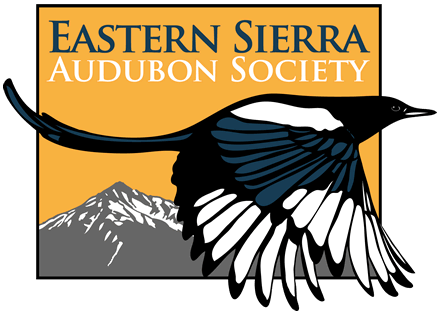by Tom and Jo Heindel
Seasons come and go but from a birding viewpoint some are better than others. Most birders have experienced migrations that are easily forgettable; such was not the case for the fall of 1997. It was arguably the best one ever for Inyo County. Three species were recorded in the county for the first time ever. A Purple Gallinule, found by Jon Dunn, co-author of the National Geographic Society’s Field Guide to North American Birds, at Furnace Creek Ranch on 23 September was not only a first for the county but only the third record for the state of California and the only adult as the other two were juveniles. Dozens of birders poured in from all over to view this bird and add it to their state bird list. On 30 September at Keeler a Ruff, a large shorebird with an inordinately small head and bill, was photographed. China Lake, just south of Inyo County, has a handful of records so this was a long overdue addition to the county bird list. On 5 October a Smith’s Longspur was found at Furnace Creek Ranch which is only the fifth record for the state. This fall to remember boosted the Inyo County list total to 409 species! Several other species were discovered for which there are only 1 or 2 other records. A Parasitic Jaeger was found at North Haiwee Reservoir on 13 October which was a third county record. A Dusky-capped Flycatcher was found by Debby Parker just north of Bishop on 7 November which was only the third time that bird had been seen in the county. It stayed for three days allowing excellent views to many observers. A Sprague’s Pipit was at Furnace Creek Ranch 10-18 October and was either the second or third county record. One was at Furnace Creek Ranch 2 October 1979 and 23 October 1979 and not found between those dates even though great birders searched. We are not convinced that these were two different birds and the fact that this is an especially rare bird in the state and only one other was found in all of CA during that fall makes us feel that it was probably one bird that was hiding where the birders were not birding. No one will ever know the answer to that dilemma. Many other species occurred which are considered rare in the entire state or rare away from the California coast. An Eurasian Wigeon was at North Haiwee Reservoir 8 November. Eight Surf Scoters and a White-winged Scoter (found by visiting birder Steve Glover) were unprecedented. A Red Phalarope was at Keeler 12 September and another one found by Bob Hudson at Independence 27 November was the latest ever seen in the county. An adult Sabine’s Gull was at Tinemaha Reservoir 7 September and another at Klondike Lake, 10 miles north, the next day. Did this rare bird reverse its course and fly north the next day? Or were there two rare birds? Both were adults in similar plumage. Another enigma! A Gray Catbird was heard in north Bishop on 17 October and found the next day by Debby Parker. A Brown Thrasher was banded in Big Pine on 22 November. A Red-eyed Vireo was along the Owens River below Tinemaha dam 9 October. A beautiful male Black-throated Blue Warbler was at North Haiwee Reservoir 13 October. A Blackburnian Warbler spent 13-19 October in north Bishop. A Prairie Warbler was found by visiting birder Kathi Ellsworth near Grandview Campground in the White Mountains 2 September. A Prothonotary Warbler , found by visiting birder Michael Patten, was at Furnace Creek Ranch 10-12 October and an immature Painted Bunting, also found by Michael Patten, was there 24 September to 10 October. Other more regularly occurring species but still considered rare to very uncommon included: Pacific Loon, Greater Scaup, Hooded Merganser, White-tailed Kite, Peregrine Falcon, Vermilion Flycatcher, Winter Wren, Varied Thrush, Hermit Warbler, American Redstart, Northern Waterthrush, Rose-breasted Grosbeak, Dickcissel, American Tree Sparrow, Clay-colored Sparrow, Lark Bunting, Grasshopper Sparrow, Swamp Sparrow, White-throated Sparrow, Harris’s Sparrow, Lapland Longspur, Chestnut-collared Longspur, Bobolink, and Rusty Blackbird. WOW! Did you see all of these? Well, no matter. No one else did either although some tried! Take a deep breath because it is time to get ready for winter. Rough-legged Hawks are back and the first Northern Shrike has been in our backyard for the last few days. May the holidays and New Year bring you all the birds you desire!
Tags: blackbird, falcon, flycatcher, grosbeak, gulls, hawk, lark, longspur, loon, sparrow, thrasher, thrush, vireo, warbler, wren
